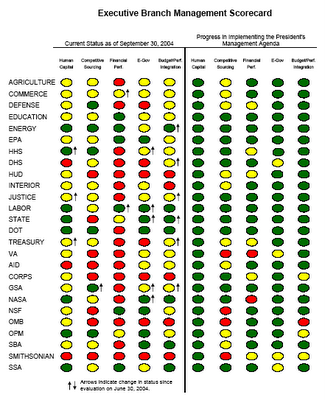No President Left Behind
 Ever seen one of these? It's an Executive Branch Management Scorecard.
Ever seen one of these? It's an Executive Branch Management Scorecard.That's right, it's how the president keeps track of the complexities of the workings of government. As you can see, it combines the information design features of a simple traffic light with the layout of a multiple-choice scantron examination.
To see a government document with this level of granularity is really disappointing. What about at least ranking things from one to ten? I never thought I'd be nostalgic about seeing "grade" report cards that rank performance from "A" to "F"! It certainly wouldn't ever be featured on the information aesthetics blog or made an info-aesthetics exemplar by digital design guru Lev Manovich.
I discovered another example this apparently long-standing genre when I read the Expanding E-Government Report, which I had been encouraged to peruse in one of the "interactive" (read "canned Q&A") sessions with IT policy-makers at Ask the White House on e-Gov. I have to say, I've read a lot of cretinous government reports in my time, but this one was truly terrible: twelve pages with moronic headings like "Being the Best" and PowerPoint-style graphics like the one below.

And did I mention that e.gov has a maddenly awful search engine that doesn't even primarily search its own site?
You can see more bad e-Gov related information design in the PowerPoint slide below, which I found on the White House website. It has all the best PowerPoint cliches of the "advanced" user: 3-D arrows, check boxes, color shading, etc. in the fossil record that is depicted.
 Anyone who follows the field and the work of academic experts like Jane Fountain who study the "virtual state" knows that the federal government has not come very far since the Clinton administration, when the focus was access to online forms.
Anyone who follows the field and the work of academic experts like Jane Fountain who study the "virtual state" knows that the federal government has not come very far since the Clinton administration, when the focus was access to online forms.Then again, if I thought that was bad, the recent report to the president about "intellectual property" from the Council of Economic Advisors was even more discouraging, when it came to lowering the bar for public discourse about technology. The primer on Open Source in the chapter on "The Role of Intellectual Property in the Economy" indicated just how much the big publishers in the commercial software industry are calling the shots.
The German "Information cocktail" approach seems to be a much more sophisticated method for bringing numerical information to the senses, particularly during this, the holiday season. Cheers!
Labels: powerpoint politics, White House

0 Comments:
Post a Comment
<< Home